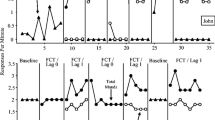Abstract
We evaluated a procedure consisting of functional communication training (FCT) and a chained schedule of reinforcement to treat multiply maintained challenging behavior exhibited by an individual diagnosed with autism. First, we conducted a functional analysis that yielded results indicating that challenging behavior served multiple functions. Next, we implemented a chained schedule of reinforcement procedure in which during the initial link, mands for a stimulus were reinforced on a fixed ratio (FR) 1 schedule of reinforcement. The participant’s access to the stimulus signaled the second link of the chained schedule that consisted of a fixed time (FT) 30 s schedule in which all three functional reinforcers were provided. Last, we modified the chained schedule procedure to increase ease of implementation and promote compliance with academic tasks. The results showed that the treatment was successful in the treatment of challenging behavior with multiple functions. Future directions in the development of treatments that simultaneously address multiple functions are discussed.

Similar content being viewed by others
References
Bijou, S. W., Peterson, R. F., & Ault, M. H. (1968). A method to integrate descriptive and experimental field studies at the level of data and empirical concepts. Journal of Applied Behavior Analysis, 1, 175–191.
Borrero, C., & Vollmer, T. R. (2006). Experimental analysis and treatment of multiply controlled problem behavior: A systematic replication and extension. Journal of Applied Behavior Analysis, 39, 375–379.
Braithwaite, K. L., & Richdale, A. L. (2000). Functional communication training to replace challenging behavior across two behavioral outcomes. Behavioral Interventions, 15, 21–36.
Carr, E. G., & Durand, V. M. (1985). Reducing behavior problems through functional communication training. Journal of Applied Behavior Analysis, 18, 111–126.
Day, H. M., Horner, R. H., & O'Neill, R. E. (1994). Multiple functions of problem behaviors: Assessment and intervention. Journal of Applied Behavior Analysis, 27, 279–289.
Falcomata, T. S., Roane, H. S., Muething, C. S., Stephenson, K. M., & Ing, A. D. (2012). Functional communication training and chained schedules of reinforcement to treat challenging behavior maintained by terminations of activity interruptions. Behavior Modification. Published Online First: 9 February 2012. doi:10.1177/0145445511433821.
Ferster, C. B., & Skinner, B. F. (1957). Schedules of reinforcement. New York, NY: Appleton.
Fisher, W. W., Piazza, C. C., & Chiang, C. L. (1996). Effects of equal and unequal reinforcer duration during functional analysis. Journal of Applied Behavior Analysis, 29, 117–120.
Gollub, L. (1977). Conditioned reinforcement: Schedule effects. In W. K. Honig & J. E. R. Staddon (Eds.), Handbook of operant behavior (pp. 288–312). Englewood Cliffs, NJ: Prentice Hall.
Hagopian, L. P., Wilson, D. M., & Wilder, D. A. (2001). Assessment and treatment of problem behavior maintained by escape from attention and access to tangible items. Journal of Applied Behavior Analysis, 34, 229–232.
Hanley, G. P., Iwata, B. A., & Thompson, R. H. (2001). Reinforcement schedule thinning following treatment with functional communication training. Journal of Applied Behavior Analysis, 34, 17–38.
Hanley, G. P., Heal, N. A., Tiger, J. H., & Ingvarsson, E. T. (2007). Evaluation of a classwide teaching program for developing preschool life skills. Journal of Applied Behavior Analysis, 40, 277–300.
Iwata, B. A., Dorsey, M. F., Slifer, K. J., Bauman, K. E., & Richman, G. S. (1994). Toward a functional analysis of self-injury. Journal of Applied Behavior Analysis, 27, 197–209.
Love, J. R., Carr, J. E., & LeBlanc, L. A. (2009). Functional assessment of problem behavior in children with autism spectrum disorders: A summary of 32 outpatient cases. Journal of Autism and Developmental Disabilities, 39, 363–372.
Neidert, P. L., Iwata, B. A., & Dozier, C. L. (2005). Treatment of multiply controlled problem behavior with procedural variations of differential reinforcement. Exceptionality, 13, 45–53.
O’Neill, R. E., Horner, R. H., Albin, R. W., Sprague, J. R., Storey, K., & Newton, J. S. (1997). Functional assessment and program development for problem behavior: A practical handbook (2nd ed.). Pacific Grove, CA: Brooks/Cole.
O’Reilly, M., Rispoli, M., Davis, T., Machalicek, W., Lang, R., Sigafoos, J., et al. (2010). Functional analysis of challenging behavior in children with autism spectrum disorders: A summary of 10 cases. Research in Autism Spectrum Disorders, 4, 1–10.
Reese, R. M., Richman, D. M., Zarcone, J., & Zarcone, T. (2003). Individualizing functional assessments for children with autism: The contribution of perseverative behavior and sensory disturbances to disruptive behavior. Focus on Autism and Other Developmental Disabilities, 18, 87–92.
Roane, H. S., Vollmer, T. R., Ringdahl, J. E., & Marcus, B. A. (1998). Evaluation of a brief stimulus preference assessment. Journal of Applied Behavior Analysis, 31, 605-620
Schopler, E., Reichler, R. J., & Renner, B. R. (1988). The childhood autism rating scale (CARS). Los Angeles, CA: Western Psychological Services.
Sigafoos, J., & Meikle, B. (1996). Functional communication training for the treatment of multiply determined challenging behavior in two boys with autism. Behavior Modification, 20, 60–84.
Tiger, J. H., Hanley, G. P., & Heal, N. A. (2006). The effectiveness of and preschoolers’ preferences for variations of multiple-schedule arrangements. Journal of Applied Behavior Analysis, 39, 475–488.
Touchette, P. E., MacDonald, R. F., & Langer, S. N. (1985). A scatter plot for identifying stimulus control of problem behavior. Journal of Applied Behavior Analysis, 18, 343–351.
Vollmer, T. R., Iwata, B. A., Zarcone, J. R., Smith, R. G., & Mazaleski, J. L. (1993). The role of attention in the treatment of attention-maintained self-injurious behavior: Noncontingent reinforcement and differential reinforcement of other behavior. Journal of Applied Behavior Analysis, 26, 9–21.
Author information
Authors and Affiliations
Corresponding author
Rights and permissions
About this article
Cite this article
Falcomata, T.S., White, P., Muething, C.S. et al. A Functional Communication Training and Chained Schedule Procedure to Treat Challenging Behavior with Multiple Functions. J Dev Phys Disabil 24, 529–538 (2012). https://doi.org/10.1007/s10882-012-9287-z
Published:
Issue Date:
DOI: https://doi.org/10.1007/s10882-012-9287-z




